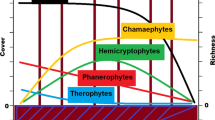Summary
Ten 20×20 m plots were surveyed in each of three site classes (poor, medium, and good) for Populus grandidentata growth on three different podzolized soils in western Cheboygan County, Michigan, 14 miles south of the Straits of Mackinac. A phytosociological table shows that exclusive differential species distinguish communities of the poor sites from those of the good sites. In both groups some species are persistent from earlier stages of succession and others are invading species responsible for more recent succes sional change. The medium site class lacks differential species. Poor-site stands are developing toward Pinus resinosa-P. strobus forest and Quercus rubra-Pinus forest. Good-site stands are developing toward Acer-Fagus forest, a mesophytic community characteristic of the “northern hardwoods” regional climax. Medium-site stands have potentialities for development toward either the Pinus communities or the Acer-Fagus community, but predominantly in the direction of the latter.
Zusammenfassung
Zehn Aufnahmen von jeder Standortsklasse (arm, mittel, gut) hinsichtlich des Wachstums von Populus grandidentata auf drei verschiedenen podsolierten Böden in West Cheboygan County, Michigan, 14 Meilen südlich der Mackinacstrasse werden vorgelegt. Eine phytosoziologische Tabelle erweist, dass die ausschliesslichen Differentialarten die Pflanzengesellschaften der armen Standorte von jenen der guten unterscheiden. Einige Arten der beiden Gruppen haben sich aus früheren Sukzessionsstufen erhalten, während einige andere als Eindringlinge aufzufassen sind. Der Mittelstandortsklasse fehlen die Differentialarten. Die Pflanzengesellschaften der armen Standortsklasse entwickeln sich zum Pinus resinosa-P. strobus-Wald und zum Quercus rubra-Wald, Gesellschaften der guten Standortsklasse zum Acer-Fagus-Wald einer mesophytischen Gesellschaft, die für den „nördlichen Laubwald” den Regionalklimax darstellt. Mediumstandortsbestände können sich entweder zu den Pinus-Gesellschaften oder aber zu der Acer-Fagus-Gesellschaft (meistens zu letzterer) entwickeln.
Résumé
Dix relevés de 20 x 20 m. ont été faits dans chacune des trois catégories (pauvre, moyenne et bonne) de sites de rapportant à la croissance de Populus grandidentata sur trois soils podsolizés dans la partie occidentale du Comté de Cheboygan (Michigan), 14 miles au Sud du Détroit de Mackinac.
Le tableau phytosociologique montre que les espèces différentielles exclusives distinguent nettement la végétation des sites pauvres de celle des bons sites. Dans les deux groupes, quelques espèces des étapes de l'évolution précédente se maintiennent tandis que d'autres s'installent, ébauchant une évolution ultérieure. La végétation des sites moyens ne possède pas d' espèces différentielles. La végétation des sites pauvres se développe vers la forêt de Pinus resinosa — P. strobus et la forêt de Quercus rubra-Pinus. La végétation des bons sites se développe vers la forêt d' Acer-Fagus, association caractéristique du climax regional („northern hardwoods”). La végétation des sites moyens se développe soit vers les associations de Pinus ou plus souvent vers l'association d' Acer-Fagus.
Similar content being viewed by others
Literature cited
Barnes, Burton, V., 1959 — Natural variation and clonal development of Populus tremuloides and P. grandidentata in Northern Lower Michigan. Unpublished Ph. D. thesis, University of Michigan Library, Ann Arbor.
—, 1961 — Hybrid aspens in the Lower Peninsula of Michigan. Rhodora 63: 311–324.
Braun-Blanquet, J., 1951 — Pflanzensoziologie. Springer Verlag: Wien.
Dansereau, Pierre, 1959 — Phytogeographia Laurentiana. II The principal plant associations of the Saint Lawrence Valley. Contrib. Inst. Bot. Univ. Montreal, No 75, 147 pp.
Ellenberg, H., 1956 — Aufgaben und Methoden der Vegetationskunde. In Grundlagen der Vegetationsgliederung, Bd. IV of Einführung in die Phytologie, hgb. von Heinrich Walter. Stuttgart: Eugen Ulmer.
Farmer, Robert, E., Jr., 1958 — Some effects of prescribed burning following clear-cutting in poor site aspen. Master's thesis, Department of Forestry, University of Michigan, Ann Arbor (unpublished).
Fernald, M. L., 1950 — Gray's Manual of Botany, 8th ed., New York: American Book Co.
Gates, Frank C., 1930 — Aspen association in Northern Lower Michigan. Bot. Gaz. 90: 233–259.
Graham, S. A., C. E. Westell, Jr. & R. P. Harrison, 1954. A study of the aspens in the Lower Peninsula of Michigan. Phoenix Memorial Project No. 29, 127 pp. typescript, illus. (unpublished progress report).
Grandtner, Miroslav, M., 1960 — La Forêt de Beauséjour, Comte de Lévis, Quebec: Étude Phytosociologique. Laval University Forest Research Foundation (Quebec), Contribution No. 7, 62 pp.
Kilburn, Paul D., 1960 — Effect of settlement on the vegetation of the University of Michigan Biological Station. Pap. Michigan Acad. Sci., Arts, & Ltrs. 45: 77–81.
Kittredge, Joseph Jr., 1938 — The interrelationships of habitat, growth rate, and associated vegetation in the aspen community of Minnesota and Wisconsin. Ecol. Mon. 8: 151–246.
Koenig, Robert, L., 1960 — Variation in tree size and quality of naturally occurring Big. tooth Aspen clones in Northern Lower Michigan. Master's thesis, Department of Forestry, University of Michigan, Ann Arbor. (unpublished).
U.S. Department of Agriculture, Soil Conservation Service. 1961a. Productive potential of soils for wood crops, Michigan, Lower Peninsula. Michigan Soil Conservation Service Woodland Tech. Note No. 16, 6 pp., mimeographed.
U.S. Department of Agriculture, Soil Conservation Service, 1961b. National Cooperative Soil Survey in Michigan: Emmet Series. 2 pp., mimeographed.
U.S. Department of Agriculture, Soil Conservation Service, 1958. National Cooperative Soil Survey in Michigan: Rubicon Series. 2 pp., mimeographed.
U.S. Department of Commerce, Weather Bureau. 1942–1961. Climatological Data, State of Michigan. Vol. 57–76.
Voss, E. G., 1956 — A history of floristics in the Douglas Lake region (Emmet and Cheboygan Counties), Michigan, with an account of rejected records. J.Sci.Labs., Denison Univ. 44: 16–75.
Author information
Authors and Affiliations
Additional information
This study was aided by research assistance and by related investigations supported by National Science Foundation Grant G-17833, “Phytosociological Survey in Michigan”, W. S. Benninghoff, principal investigator. The authors wish to acknowledge guidance in the field and advice on forestry data provided by Dr. Robert Zahner, School of Natural Resources, The University of Michigan.
Rights and permissions
About this article
Cite this article
Benninghoff, W.S., Cramer, K.J. Phytosociological analysis of aspen communities on three site classes for populus grandidentata in western Cheboygan County, Michigan. Vegetatio Acta Geobot 11, 253–264 (1963). https://doi.org/10.1007/BF00303792
Received:
Issue Date:
DOI: https://doi.org/10.1007/BF00303792



